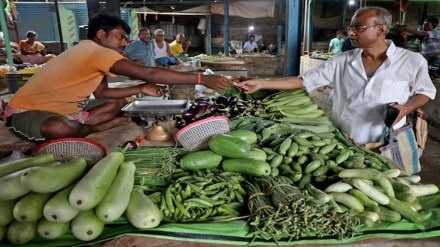In some positive news for the economy, inflation may be finally showing some signs of easing. Consumer Price Index Inflation or popularly known as the CPI inflation is down to 5.48% in November. This is a sharp drop from the 6.2% print in October. A dip in prices of food items and beverages has been ascribed as the main reason for the drop in inflation numbers in November.
According to the data released by the Ministry of Statistics, November food inflation has dropped to 9.04% from 10.87 percent in October. This is considered as the primary reason for the elevated inflation print in October.
Sujan Hajra, Chief Economist & Executive Director, Anand Rathi Shares and Stock Brokers pointed out that “while food inflation eased slightly, driven by a decline in vegetable prices, which showed sequential moderation, food inflation remained elevated due to higher edible oil prices. At the same time, core inflation displayed an uptick, warranting attention. Looking ahead, we anticipate further moderation in food prices, supported by a robust Rabi harvest. This should provide some relief to inflationary pressures. The Monetary Policy Committee (MPC) will have the benefit of another round of inflation data before its next meeting. Given the evolving inflation dynamics, the Reserve Bank of India (RBI) may consider initiating a shallow rate cut cycle starting February, contingent on favourable trends in inflation and no sharp acceleration of growth.”
Akhil Mittal, Senior Fund Manager – Fixed Income, Tata Asset Management added that, “We expect softening in food price inflation to continue as winters set in. We expect inflation may fall towards 5.2-5.3% for December 2024. With inflation expected to soften going ahead, it opens up space for RBI for policy easing to support growth.”
Food inflation is still uncomfortably high
That said, food inflation continues to remain at uncomfortably high levels above 9%. Madhavi Arora, Chief Economist, Emkay Global Financial Services explained that ““Even with no surprises on the Nov CPI print, and sequential easing seen in perishable food items, the food inflation stays uncomfortably high at about 9% on an annualised basis and is lending pressure to the headline print to stay above 5%. Sequential easing in Core cpi inflation, on the other hand, continues to depict weaker domestic demand, led by a negative output gap. We maintain our FY25 forecast at 4.9% with 4Q easing to an average of ~4.75%. However, the inflation easing head does not guarantee a deep, linear rate cut cycle. The The policy trade-offs are getting acute with tricky and small window of conventional rate cuts as global dynamics turn more fluid. Besides, mounting FX pressures and increasing cost of FX intervention will need to be weighed before cutting rates deeply ahead. We do not, for now, rule out a cut in Feb-25, but would be more comfortable taking a firm call closer to the policy window, esp. with new MPC in order. We also keep a watch on unconventional easing measures, specifically the gradual easing of regulatory lending norms ahead, to re-spur the waning credit offtake.”
Industrial output improves
In other relevant data that is out, Industrial production in October 2024 showed a slight improvement at 3.5% from 3.1% in September. Moderate uptick has been seen across all sectors – manufacturing, mining as well as electricity. However, growth is much slower as compared to last October when industrial output came in at 11.9%. Of course this was also an impact of the base factor.
The use-based classification also shows positive growth, with consumer durables dipping slightly compared to last month (5.9% vs 6.5%) but still leading growth alongside infrastructure goods (4.0%). For the April-Oct 2024 period, industrial output grew by 4.0%, albeit materially weaker than the 7.0% growth seen during the same period.
Responding to the data, Suman Chowdhury, Executive Director & Chief Economist, Acuite Ratings & Research said that they “expect IIP growth to pick up in H2FY25 on the back of an improvement in consumer demand, supported by the wedding season and the kharif harvest. Further, government spending particularly on capital expenditure is also likely to see a rapid uptick over the next few months. Nevertheless, the annualized growth in IIP for FY25 is set to slow down to around 4.5% given the weaker growth in H1.”
